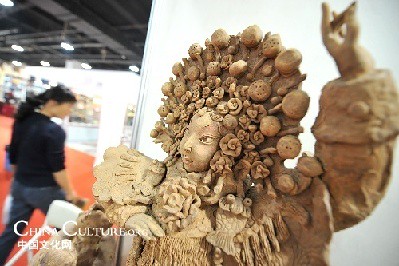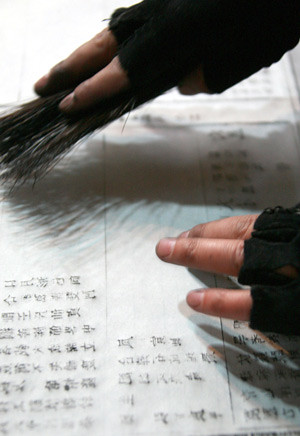| Home > Living in China > Art |
Folk Songs
1. Course of Historical DeveloPment
As was the case with other ancient peoples, Chinese folk songs originated in primitive hunting, ritual, mating and herding activities. So, from an early period there was established a realistic artistic tradition based on work, food production, funeral Customs, etc. For instance, a song in the Annals of the States of Wu and Yue has the following lines: ',Chop the bamboo and pile it up; delve in the earth and hunt the game.-' Tradition has it that this poem dates from the time of the Yellow Emperor; it Succinctly expresses the whole course of primitive hunting and laboring activities. In Master Lob Annals, we find: "Yu went hunting. He saw a woman on Mount Tu. He passed her by, and toured the southern lands. The woman of Mount TU thereupon sent her serving woman to await YU on the orth side of Mount TU. The woman made a song, which went as follows 'Waiting, oh waiting for you!' This was the first song created in the south." Literary historians regard this as the source of love songs in the Chinese folk tradition. In the same work, it says, "ln the music of Lord Getian in ancient times, three men waved the tails of oxen and danced, singing eight songs...'- This is a lively picture of ceremonial singing and dancing held in gratitude for a bumper harvest. These splendid records of early folk songs not only provide us with some understanding of social life at that time, they also show us that people who lived several thousand years ago had reached a Surprising high artistic level in using colloquial language to examine, sum up and describe their actions and emoti0ns relating to work, love, aspirations and beliefs.
In about the sixth century BC, there appeared the first collection of poems and songs in Chinese history - the Book of Songs. Of the 305 items in this work, 165 are folk songs and poems, know collectively as "teng'. They are also called "the leng of the 15 states", as they are folk compositions handed down 0ver a period of about 500 years (1 006- 57o BC)from 15 states or territories. The socio- historical aspect of these poems is not only wide- ranging but also a model of incisiveness worthy of being called a "Book fgenesis" which reveals the social life of 500 years of the Zhou people throuhy of special mention is the fact that most of the poems and songs use the f0ur-words-to-a-line format. This stable and widespread attern laid an important foundation for the progress and diversification of later Chinese folk songs. The opening work in the Book of Songs: "By the riverside are cooing/A pair of turtledoves/A good young man is wooing/A maiden fair he loves." displays a fresh and lucid style; more0ver, it has all the ingredients of a full-f ledged song.
During the Han Dynasty, folksongs as a genre spread widely and unceasingly, and their forms developed and changed. Throughout the Qin and Han dynasties, the Music Conservatory, which was set up to collect the songs and music flourishing among the common people, was most influential in recording and promoting the development of this type of music. As a result, during the Han and Wei dynasties, the common people's songs and poetry which had been handed down in this way were called "Music Conservatory" pieces. At the same time, the basic structure of these folksongs five words to a line was called the '-Music Conservatory F0rm". This Music Conservatory genre was another of the high spots of Chinese folk music which occurred repeatedly following the guoteng or "National Style" of the Book of Songs. In the course of 5O0 or 600 years of development, not only did it spread widely among the ordinary people, it also directly influenced the musical and poetic creations of men of letters. The collcction of Music Conservatory Verese, compiled by Kuo Maoqian of the Song Dynasty in 100 volumes, is an embodiment of the artistic achievements of both the folk and the literary Music Conservatory styles. Among the works contained in this compilation, the Fifteen Miliary Expedition Songs, Wayside Mulberries, Thc Peacocks Fly Southeast, Song of Mulan and Song Sung Deep in the Night from the Songs of Wu are still moving when read, even though the music which accompanied them has been lost. The Two Songs Sung at Midnight notes that there are hundreds of kinds of ballads, but describes the "midnight" songs as the most haunting, with clear and natural expression from stringed and wind instruments. The Music Conservatory songs, which had five words to the line, gradually combined with the Nati0nal Style, which used four woods to the line, to lay the groundwork for the styles of songs which emerged later, having seven words to the line and alternating short and long lines.
Against the historical background of the promotion of Cultural exchanges with the outside world by the Tang Dynasty rulers and the absorption of the music of neighboring nationalities, Chinese folk music preserved its vitality. Liu Yuxi (772-842), a mid-Tang poet, was greatly excited when he heard a local folksong in what is now ichuan Province, called Bambo0 Branch. He immediately set about writing ten songs modeled on it. The most famous of these contai s the lines: "Between the willows green the river flows along/My dear one in a b0at is heard t0 sing a song/The west is veiled in rain, the east enjoys Sunshine/ Others say the day is dark, but to us the day is fine.'- Another song goes, "The mountain's red with peach blossoms above/The shore is washed by spring water elow/ Red blossoms fade as fast as my gallant's love/The river, like my sorr0w, will forever flow." From these imitations we can appreciate the free-flowing style of the seven-word-to-the-line form of folksong and the oblique expression of meaning inherent in the folksong style. In his Crop-Planting Song he left a valuable record for later generations of a lengthy tradition among farmers of singing while they planted crops in their fields, which he observed in Lianzhou, Guangdong Province. Another type of folksong extant at this period has been preserved among the records found at Dunhuang, and known as the TaiZi wugengzhuan and Sifu Wugnegzhuuan. These songs were divided into a series of five parts, or gap They were particularly suitable for expressing emotions of nostalgia and longing, and were popular in the Tang and Song dynasties; in various forms, they could be heard alt over the country as late as the beginning of the Qing Dynasty. In summary, the most important characteristic of the folksongs of the Tang period, apart from the appearance of new forms, was that the types using seven words to the line achieved all-round maturity.
During the Song, Yuan, Ming and Qing dynasties, the traditional folksongs 0f farmers, fishermen, mountain dwellers and boatmen continued to be handed down; at the same time, the burgeoning of the urban commercial economy gave rise to new types of songs, called Xiaodiso. A classic one using seven words to the line is this 0ne, fr0m a Song Dynasty stowller's prompt book: "The crescent moon shines down all over the land/On the joytul and the sad alike/On the families united and on the homeless wanderers." The most widespread form of such folksongs was the "spring tune" type, which had four stanzas: respectively, introduction, theme, Support and wrap-up. During the Ming Dynasty, the scholar Feng Menglong compiled collections of folksongs titled Mountain Songs, Hanging Branch and oleader In the Qing Dynasty, Wang Tingshao put together his Rainbow Tunes, and Hua Guangsheng compiled Lingering Snowy Echoes, Ballads of the Deep South and Whimsical Collection. Most of these were songs popular among the common people of the cities at that period. Eight pieces in the last book (published in 1837), including The Embribered Pouch, Song of the Screcn Window Shoes Embroidered in Red Greeen Wollws and Song of hc Fresh Flowers (i.e.jasmine), all belong to the folksong genre, and were recorded in the gongchiPu notation. Thus, we can get an idea of how folksongs had developed to the stage at which they were treated as a serious musical form.
In brief, by the time the Qing Dynasty was Supplanted by the Republic of China, the Chinese folksongs, after dissemination, alteration and creation over a period of several thousand years had, on one hand, matured and become enriched in their subject matter, scope and structure, as they had had to suit a variety of social strata and common environments; on the other, as they developed they had absorbed a rich variety of national and local styles from the different areas they had sprung up in. These folksongs, with their long history, unbroken tradition, variety of form, and rich and colorfulcontents, are a treaSure store of Chinese Culture. From this aspect, there Are people who insist that Chinese folksongs are an "encyclopedia of the social life of the Chinese nation" and a rich source of nourishment for other types of music which will never dry up.
Art
 more
moreThe Dawn Breaks
(the prehistoric period - the 16th century BC) Ancient documents

2008 World Craft Council General
The 16th WCC General Assembly was held in China’s southern city of

Traditional wooden movable
Villagers print the book of the Chen's family tree

Customs
 more
moreChinese Kungfu
Everybody was kungfu fighting
Niels Tsai, a kungfu enthusiast from Malaysia, was halfway up misty
Tai chi helps cut pain of knee arthritis
The traditional Chinese form of exercise known as tai chi can help
Kungfu Taste: Learn Martial Art in Shaolin Temple
The mention of Shaolin Temple conjures up images of a quiet and




 print
print  email
email  Favorite
Favorite  Transtlate
Transtlate 
